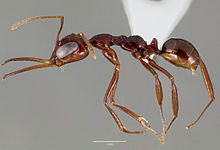Myrmoteras
| Myrmoteras | |
|---|---|
 |
|
| M. iriodum worker from Malaysia | |
| Scientific classification | |
| Kingdom: | Animalia |
| Phylum: | Arthropoda |
| Class: | Insecta |
| Order: | Hymenoptera |
| Family: | Formicidae |
| Subfamily: | Formicinae |
| Tribe: |
Myrmoteratini Emery, 1895 |
| Genus: |
Myrmoteras Forel, 1893 |
| Type species | |
|
Myrmoteras binghamii Forel, 1893 |
|
| Diversity | |
| 41 species | |
Myrmoteras is a genus of ants in the subfamily Formicinae and the sole member of the tribe Myrmoteratini. They have enormous eyes, a character found in other ancient genera, and extremely elongated mandibles with eight to 16 teeth. These work as trap-jaws and can open up to 270°.
While the elongated mandibles look superficially similar to those of the basal Myrmecia, the mechanism is, as a whole, totally dissimilar and is rather convergent to that of the ponerine genera Anochetus and Odontomachus, and the myrmicine Strumigenys. The trigger mechanism of the trap-jaw-like mandibles of Myrmoteras consists of two hairs. Other trap-jawed genera are Daceton, Acanthognathus, Orectognathus, Microdaceton, and Epitritus.
Myrmoteras occurs in the Indo-Malayan region.
...
Wikipedia
